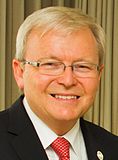2013 Australian federal election - Simple English Wikipedia, the free encyclopedia
| |||||||||||||||||||||||||||||||||||||||||||||||||
All 150 seats in the House of Representatives 76 seats were needed for a majority 40 (of the 76) seats in the Senate | |||||||||||||||||||||||||||||||||||||||||||||||||
|---|---|---|---|---|---|---|---|---|---|---|---|---|---|---|---|---|---|---|---|---|---|---|---|---|---|---|---|---|---|---|---|---|---|---|---|---|---|---|---|---|---|---|---|---|---|---|---|---|---|
| Opinion polls | |||||||||||||||||||||||||||||||||||||||||||||||||
| Registered | 14,723,385 | ||||||||||||||||||||||||||||||||||||||||||||||||
| Turnout | 93.2% | ||||||||||||||||||||||||||||||||||||||||||||||||
| |||||||||||||||||||||||||||||||||||||||||||||||||
| |||||||||||||||||||||||||||||||||||||||||||||||||
The 2013 Australian federal election to elect the members of the 44th Parliament of Australia took place on 7 September 2013. The centre-right Liberal/National Coalition opposition led by Opposition leader Tony Abbott of the Liberal Party of Australia and Coalition partner the National Party of Australia, led by Warren Truss, beat the incumbent centre-left Labor Party government of Prime Minister Kevin Rudd.
The 44th Parliament of Australia opened on 12 November 2013, with the members of the House of Representatives and territory senators sworn in.[1] The state senators were sworn in by the next Governor-General Peter Cosgrove on 7 July 2014, with their six-year terms commencing on 1 July.[2]
References
[change | change source]- ↑ "Senate - Official Hansard - No. 1, 2013" (PDF). Parliament of Australia. 12 November 2013. p. 1,2. Retrieved 15 April 2022.
- ↑ "2013 Federal Election Finally Complete". Australianpolitics.com. 7 July 2014. Retrieved 19 March 2018.


 French
French Deutsch
Deutsch



